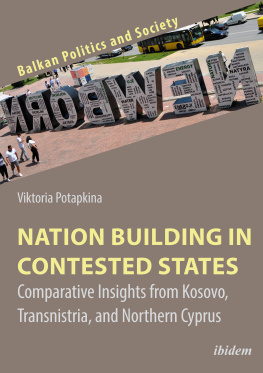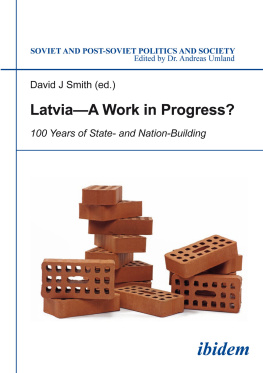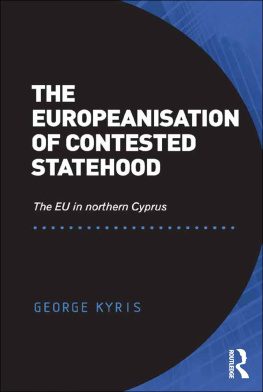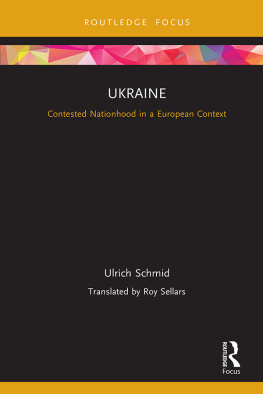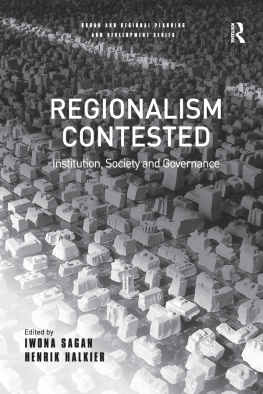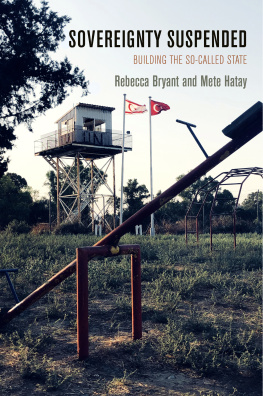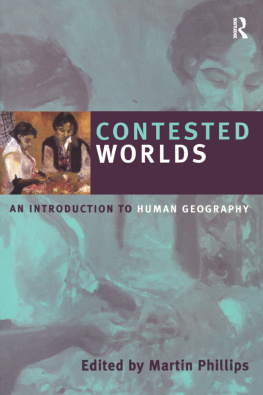ibidem-Press, Stuttgart
Acknowledgments
This book is based on my PhD thesis, and I am grateful to Universitat Pompeu Fabra for being my academic home during the time I spent writing it. I want to thank all the professors for their advice, critique and guidance. It was a long, but greatly enriching venture.
My utmost gratitude goes to my thesis supervisor, Dr. Klaus-Jrgen Nagel, who generously offered his time and expertise to discuss my work with me. I am thankful for his invaluable suggestions, endless encouragement, deliberation and guidance from day one.
I would like to thank my friends and colleagues, who took the time to discuss my research with me, read various drafts and chapters, and generally supported me every step of the way.
I am grateful to all the people who took their time to share their insight and observations with me in and about Northern Cyprus and Kosovo during the time I spent there.
Finally, I would like to thank my family who have supported me during this uneasy process. My most sincere thanks go to my parents, grandparents and brother, who have provided me with unconditional support and encouragement. This book would not have been possible without their unfailing support.
Contents
1. Introduction
The world map, with its legally divided sovereign states and neatly categorized territories, provides us with a sense of completion found within its colors and lines. After waves of state creation occurred in South America in the 19 th century, in Europe after World War I, in Asia, Africa, the Caribbean and the Pacific after World War II, and finally in Eastern, Central and Southern Europe after the breakup of the socialist block, the international community became largely reluctant to undertake further territorial revision. The view of the world map has since remained very static, while the world order rather unaccepting of major changes.
It seems that the gaps and blanks of the map have been filled, entities formed, and territories redistributed. However, hiding right beneath the surface are entities that do not fall neatly into the internationally accepted norms and concepts; entities that challenge the generally accepted understanding of statehood and world order. This book focuses on such entities, which in spite of having their territories formally included within the borders of another state, by and large do not identify with them. Unlike stateless nations, these entities have declared independence from their parent state and govern within their proclaimed territory, carrying out the practices of both state and nation building. They actively seek international recognition, however, are unable to receive it.
Not without much confusion, these entities have been referred to by numerous academics, policy analysts, politicians and journalists as contested states, unrecognized or de facto states, breakaway territories, secessionist entities, para- or pseudo-states, quasi-states, or informal states, to name just a few. Whichever term is used, a quick glimpse on the world map makes it apparent that the entities in question are small, in the majority of cases with populations of less than half a million people, but sometimes as few as several thousand. They appear in special, painful cases, oftentimes linked with war, conflict and contested territories.
These contested states are generally seen as nonexistent in international relations, as they have failed to gain full recognition or, oftentimes, barely any recognition at all. Even if none or only a few states recognize the legitimate existence of these entities, they, nevertheless, insist on their right to self-determination and statehood. In addition to their lack of international recognition, most of these contested states also lack strong state structures, and yet continue their existence. They pose a challenge to geographical and historical assumptions.
The persistence of contested states as territorial units is both intellectually puzzling and problematic. On the one hand, the lack of international recognition is a nearly sufficient factor for the seizing of existence, while on the other, the ability for ongoing existence of these small, unrecognized states requires explaining. Unlike the majority of academic literature written on the topic, this book will not look at the international implications or conflict resolution, but rather focus inwards. The ongoing existence of contested states cannot be explained and understood simply through the study of external factors and their implications. Although external support of patron states is crucial, contested states have populations, without the support or involvement of which they would not have a reason to exist. Thus, to see the full picture, we must look inside these entities, to the internal forces that create support from within the state. Understanding internal dynamics and the way support is gathered from within will provide a deeper understanding of the emergence, development and ongoing existence of contested states.
The available evidence suggests that the population of most contested states share a high degree of common identity as a nation. Furthermore, one can observe that all the current contested states have adopted a state flag, a national anthem, a state coat of arms, new national holidays, currencies, stamps and other symbolic attributes of statehood. They also build museums, erect statues, rename streets, have their own school curricula, all in order to inculcate in the population a sense of common past and common allegiance to the same state, and oftentimes, the same nation.
Important sentiments and processes at play here refer to nation building and, respectively, closely related concepts of nationalism and state building. These concepts have not disappeared from the modern political scene, nor will they in the near future. They are all political in nature, even if they include important elements of culture, history, language, religion or art, amongst others. The main focus of national movements, which divide a group into a nation, distinct from their surrounding neighbors, is political, regardless of whether the end goal is an alternation to the existing state formation or political system. Neither is the impact of national movements confined within the state; many nations cut across existing state borders. Given the complex world situation, it is not surprising nationalism is still a strong force. The news is constantly filled with events around groups seeking political power for their nation and directly challenging the existence of states in their current form.
Contested states are peculiarities of the international system, but also of political science. Surprisingly, the vast majority of literature written on the topic has been by scholars of international relations and conflict studies. A single work dedicated to the analysis of the internal process occurring in all contested states does not exist. Yet the world has witnessed numerous states emerge and disappear with the influence of just external actors; however, contested states have continued their existence. This is an indicator that the people living in these territories identify and at least in some degree for whatever reason support the existence of these contested states, limited in their capacity to provide for these very same citizens. This creates an interesting puzzle and reason to dig deeper beneath the surface to uncover the reasons of why these people feel bound to the territory, entity and perhaps even to a nation.
This books focus is on the current nation building processes carried out in contested states. It aims to answer the question of whether they are at all different from the ones that took place in uncontested states. A closer look at other states will give us an insight into the exclusivity and uniqueness of the situation, allowing to draw further conclusions.

